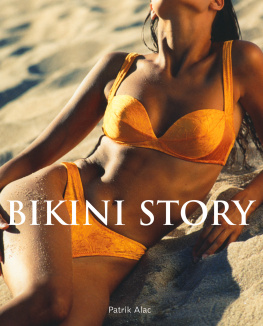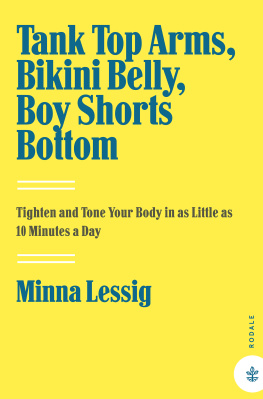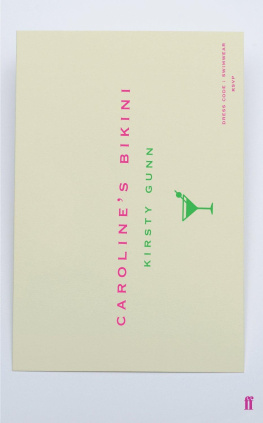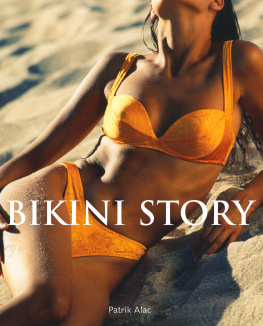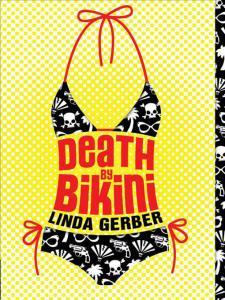Author:
Patrik Alac
Layout:
Baseline Co. Ltd
61A-63A Vo Van Tan Street
4 th Floor
District 3, Ho Chi Minh City
Vietnam
Confidential Concepts, worldwide, USA
Parkstone Press International, New York, USA
Image-Bar www.image-bar.com
All rights reserved.
No part of this publication may be reproduced or adapted without the permission of the copyright holder, throughout the world. Unless otherwise specified, copyright on the works reproduced lies with the respective photographers, artists, heirs or estates. Despite intensive research, it has not always been possible to establish copyright ownership. Where this is the case, we would appreciate notification.
ISBN: 978-1-78310-726-1
Patrik Alac
BIKINI story

Acknowledgments:
The brands: diNeila, Lenny Swimwear, RiodeSol and Pain de sucre.
Special thanks to Neila Granzoti Rudden for her postscript, and her extensive
advice concerning the selection of photos.
Contents
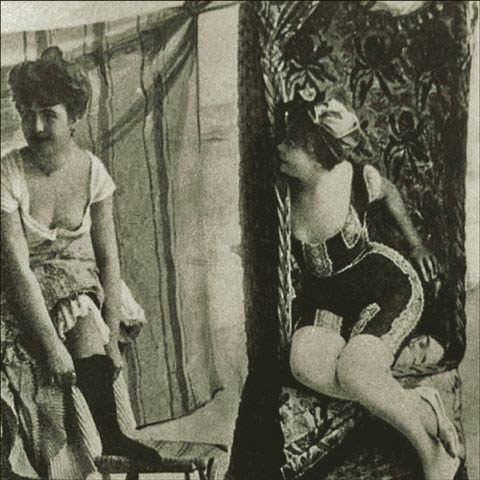
Retouched photo dating from the end
of the 19 th century showing a temporary
changing-cubicle, (details).
Introduction
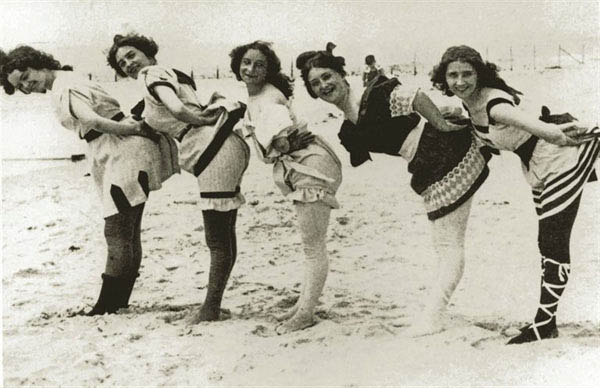
Photo of Coney Island at the beginning of the 20 th century. The holiday resort regarded by some as Sodom by the Sea seems to be living up to its reputation as these five ladies lift their skirts in the style of a dubious rendition of the French can-can. They are wearing swimming costumes that cover the entire body with the exception of the arms. It is interesting to note how many layers of material are involved. Over a woollen body-stocking a short pair of trunks is held in place by straps at the thighs; on top of which is the bathing costume proper. The Rubenesque proportions of the carefree dancing girls are typical of their time.
The beginning of a new millennium let alone a new century simply demands a quick but thorough look back at the past hundred years. Different outline sketches of the history of the twentieth century might all too quickly resort to headline-style formulae about a century of war and terrorism, a century of barbarism, and omit any mention of a great number of events and triumphs that should be rightfully regarded as entirely positive. These might seem to have been of secondary significance in relation to more sombre events, but they certainly cannot be excluded if our historical round-up of a hundred years is to retain its proper balance, if it is to be truly historical, and not be reduced to checklists of damage and destruction, of wars and disasters alike and their cost of lives and property, of the numbers of casualties, and of the people, places, and things that are now as if they had never been.
Made possible by the decline of prudish Christianity, the return of the human body to a status in which it could once more be looked at and admired is surely one of these positive events. The process of liberalisation began at the end of World War II and eventually extended across the entire Western world. It was paralleled by moralising court judgments and injunctions against it, many of them relying on ancient laws well overdue for repeal and was decisively assisted by the invention of the bikini.
Measurement of the effect of this new culture of the body has, itself, become a basis of scientific theory. It is often a level of dress formality that represents a means of establishing precisely where on the equivalent scale of personal liberties a given society has reached. In another sense, dress formality (or the lack of it) is no more than a very old and very elementary method of communication between people. Besides indicating class, rank, and social status, clothes since the 1960s have also had ideological implications. It is interesting in this regard that even something that bears no resemblance at all to an official uniform may, nonetheless, become the equivalent of a uniform for one group or another. At the head of such revolutionary sartorial tendencies with one or two scandals to celebrate its birth, and one or two outbursts of moral outrage to celebrate its coming of age - proudly stands the bikini.
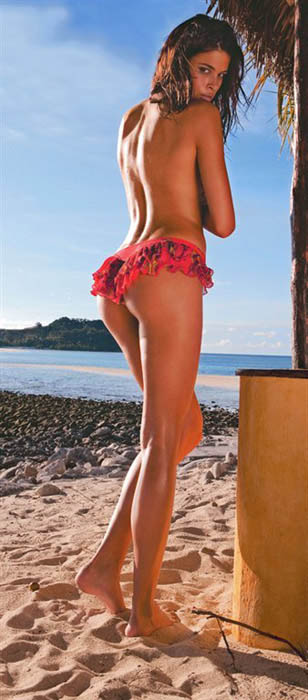
Jenna Pietersen on the beach with
a Canail bikini of Pain de sucre.
Photo: ric Deniset, 2009.
Another aspect of the upheavals since 1945 may be grasped all the better in the light of the words consumer demand and mass communications used to betoken the totality of social activities. A history lesson on the bikini would at once point out the importance of the combination of saleable goods and the benefits of advertising following World War II. It should perhaps be recalled that it was during a time of economic depression that the bikini was launched and the cinema re-launched. At the beginning of the 1950s, film directors made a lot of the almost nude look of the itty-bitty bathing costume in the hope of attracting ever more customers to their auditoriums. The popularity of the films they produced was, in turn, utilized by the designers of bikinis as a showroom to display their latest creations. It was possible to foresee the day of the publicity film-clip which had everything: goods that people wanted, described with attractive enthusiasm, all done artistically.
All the same, the spread of the smallest swimsuit in the world did not follow solely from the newly liberalized social perception of the human body but relied on the application of that perception to the realm of womens fashions. Anorexia and other eating disorders, the fanatical pursuit of sport and of bodybuilding, are only the latest manifestations of the changed vision of the human body that began in the 1950s first as a new freedom, and then, for some, as a new norm that required discipline or constraint.
All those aspects that might be included in the traditional history books are equally and demonstrably allied to the evolution of the bikini.
This book tells the story of the bikini its birth in a Parisian swimming-pool in the course of a stiflingly hot July afternoon in 1946, the scandal that followed (which relegated the bikini for ten years to the pages of illustrated magazines for men), its astounding breakthrough onto the cinema screen, the interest that it suddenly aroused in the fashion-houses, and finally its triumphant and eventually universal appearance on beaches the world over. For, from Brazil to the Mediterranean via the sandy stretches all along the Californian coast, the bikini has become an irreplaceable part of our aquatic recreational landscape.
It may be brightly coloured, multi-coloured, or a simple single colour; it may be made of expensive material, of cotton or Lycra; it may spread across the hips or leave them largely bare with just a thong or string at the back; or it may consist of no more than brief triangles, like leaves that have somehow gotten stuck on the skin. Alternatively, it may be designed strictly for effect and present a veritable barricade over the breasts. All of these forms are known and seen on a daily basis everywhere we go.


